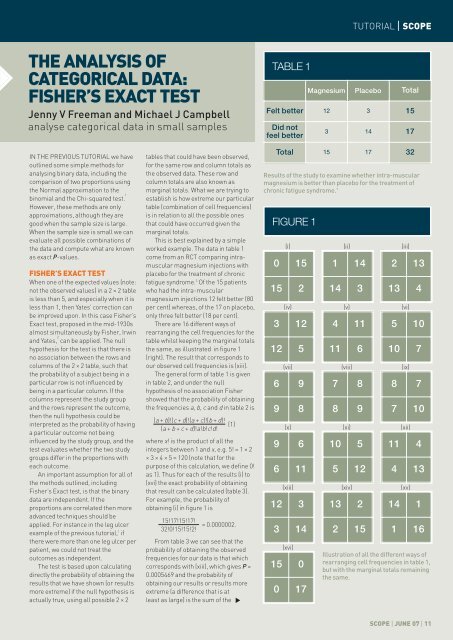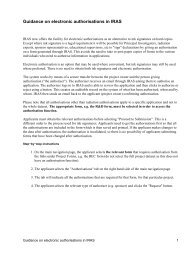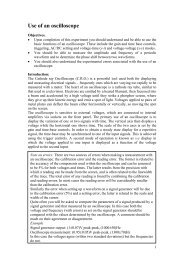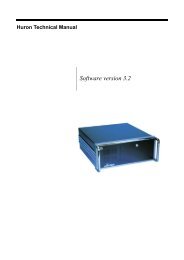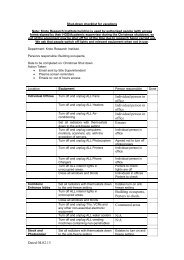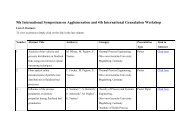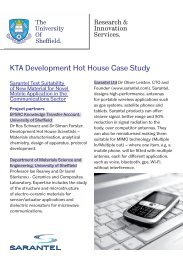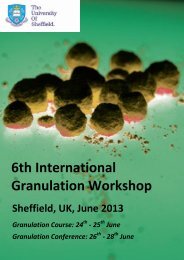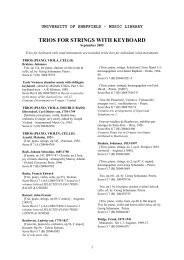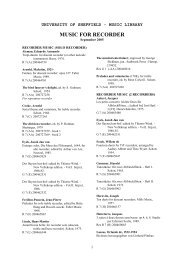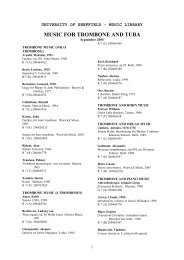THE ANALYSIS OF CATEGORICAL DATA: FISHER'S EXACT TEST
THE ANALYSIS OF CATEGORICAL DATA: FISHER'S EXACT TEST
THE ANALYSIS OF CATEGORICAL DATA: FISHER'S EXACT TEST
You also want an ePaper? Increase the reach of your titles
YUMPU automatically turns print PDFs into web optimized ePapers that Google loves.
<strong>THE</strong> <strong>ANALYSIS</strong> <strong>OF</strong><br />
<strong>CATEGORICAL</strong> <strong>DATA</strong>:<br />
FISHER’S <strong>EXACT</strong> <strong>TEST</strong><br />
Jenny V Freeman and Michael J Campbell<br />
analyse categorical data in small samples<br />
IN <strong>THE</strong> PREVIOUS TUTORIAL we have<br />
outlined some simple methods for<br />
analysing binary data, including the<br />
comparison of two proportions using<br />
the Normal approximation to the<br />
binomial and the Chi-squared test. 1<br />
However, these methods are only<br />
approximations, although they are<br />
good when the sample size is large.<br />
When the sample size is small we can<br />
evaluate all possible combinations of<br />
the data and compute what are known<br />
as exact P-values.<br />
FISHER’S <strong>EXACT</strong> <strong>TEST</strong><br />
When one of the expected values (note:<br />
not the observed values) in a 2 × 2 table<br />
is less than 5, and especially when it is<br />
less than 1, then Yates’ correction can<br />
be improved upon. In this case Fisher’s<br />
Exact test, proposed in the mid-1930s<br />
almost simultaneously by Fisher, Irwin<br />
and Yates, 2<br />
can be applied. The null<br />
hypothesis for the test is that there is<br />
no association between the rows and<br />
columns of the 2 × 2 table, such that<br />
the probability of a subject being in a<br />
particular row is not influenced by<br />
being in a particular column. If the<br />
columns represent the study group<br />
and the rows represent the outcome,<br />
then the null hypothesis could be<br />
interpreted as the probability of having<br />
a particular outcome not being<br />
influenced by the study group, and the<br />
test evaluates whether the two study<br />
groups differ in the proportions with<br />
each outcome.<br />
An important assumption for all of<br />
the methods outlined, including<br />
Fisher’s Exact test, is that the binary<br />
data are independent. If the<br />
proportions are correlated then more<br />
advanced techniques should be<br />
applied. For instance in the leg ulcer<br />
example of the previous tutorial, 1 if<br />
there were more than one leg ulcer per<br />
patient, we could not treat the<br />
outcomes as independent.<br />
The test is based upon calculating<br />
directly the probability of obtaining the<br />
results that we have shown (or results<br />
more extreme) if the null hypothesis is<br />
actually true, using all possible 2 × 2<br />
tables that could have been observed,<br />
for the same row and column totals as<br />
the observed data. These row and<br />
column totals are also known as<br />
marginal totals. What we are trying to<br />
establish is how extreme our particular<br />
table (combination of cell frequencies)<br />
is in relation to all the possible ones<br />
that could have occurred given the<br />
marginal totals.<br />
This is best explained by a simple<br />
worked example. The data in table 1<br />
come from an RCT comparing intramuscular<br />
magnesium injections with<br />
placebo for the treatment of chronic<br />
fatigue syndrome. 3 Of the 15 patients<br />
who had the intra-muscular<br />
magnesium injections 12 felt better (80<br />
per cent) whereas, of the 17 on placebo,<br />
only three felt better (18 per cent).<br />
There are 16 different ways of<br />
rearranging the cell frequencies for the<br />
table whilst keeping the marginal totals<br />
the same, as illustrated in figure 1<br />
(right). The result that corresponds to<br />
our observed cell frequencies is (xiii).<br />
The general form of table 1 is given<br />
in table 2, and under the null<br />
hypothesis of no association Fisher<br />
showed that the probability of obtaining<br />
the frequencies a, b, c and d in table 2 is<br />
(a + b)!(c + d)!(a + c)!(b + d)!<br />
(1)<br />
(a + b + c + d)!a!b!c!d!<br />
where x! is the product of all the<br />
integers between 1 and x, e.g. 5! = 1 × 2<br />
× 3 × 4 × 5 = 120 (note that for the<br />
purpose of this calculation, we define 0!<br />
as 1). Thus for each of the results (i) to<br />
(xvi) the exact probability of obtaining<br />
that result can be calculated (table 3).<br />
For example, the probability of<br />
obtaining (i) in figure 1 is<br />
15!17!15!17!<br />
= 0.0000002.<br />
32!0!15!15!2!<br />
From table 3 we can see that the<br />
probability of obtaining the observed<br />
frequencies for our data is that which<br />
corresponds with (xiii), which gives P =<br />
0.0005469 and the probability of<br />
obtaining our results or results more<br />
extreme (a difference that is at<br />
least as large) is the sum of the<br />
▼<br />
TABLE 1<br />
FIGURE 1<br />
TUTORIAL | SCOPE<br />
Total<br />
Felt better 12 3 15<br />
Did not<br />
feel better<br />
Magnesium Placebo<br />
3 14 17<br />
Total 15 17 32<br />
Results of the study to examine whether intra-muscular<br />
magnesium is better than placebo for the treatment of<br />
chronic fatigue syndrome. †<br />
(i) (ii) (iii)<br />
0 15<br />
15 2<br />
3 12<br />
12 5<br />
1 14<br />
14 3<br />
4 11<br />
11 6<br />
2 13<br />
13 4<br />
(iv) (v) (vi)<br />
6 9<br />
9 8<br />
7 8<br />
8 9<br />
5 10<br />
10 7<br />
(vii) (viii) (ix)<br />
9 6<br />
6 11<br />
10 5<br />
5 12<br />
8 7<br />
7 10<br />
(x) (xi) (xii)<br />
12 3<br />
3 14<br />
13 2<br />
2 15<br />
11 4<br />
4 13<br />
(xiii) (xiv) (xv)<br />
(xvi)<br />
15 0<br />
0 17<br />
14 1<br />
1 16<br />
Illustration of all the different ways of<br />
rearranging cell frequencies in table 1,<br />
but with the marginal totals remaining<br />
the same.<br />
SCOPE | JUNE 07 | 11
▼<br />
SCOPE | TUTORIAL<br />
TABLE 2<br />
General form of table 1.<br />
Probabilities of each of the frequency tables above,<br />
calculated using formula 1.<br />
12 | JUNE 07 | SCOPE<br />
Total<br />
Row 1 a b a + b<br />
Row 2 c d c + d<br />
Total a + b b + d<br />
TABLE 3<br />
Column 1 Column 2<br />
a + b +<br />
c + d<br />
Total a b c d P-value<br />
i 0 15 15 2 0.0000002<br />
ii 1 14 14 3 0.0000180<br />
iii 2 13 13 4 0.0004417<br />
iv 3 12 12 5 0.0049769<br />
v 4 11 11 6 0.0298613<br />
vi 5 10 10 7 0.1032349<br />
vii 6 9 9 8 0.2150728<br />
viii 7 8 8 9 0.2765221<br />
ix 8 7 7 10 0.2212177<br />
x 9 6 6 11 0.1094916<br />
xi 10 5 5 12 0.0328475<br />
xii 11 4 4 13 0.0057426<br />
xiii 12 3 3 14 0.0005469<br />
xiv 13 2 2 15 0.0000252<br />
xv 14 1 1 16 0.0000005<br />
xvi 15 0 0 17 0.0000000<br />
TABLE 4<br />
Treatment<br />
Outcome Total<br />
Clinic Home<br />
Healed 22 (18%) 17 (15%) 39<br />
Not healed 98 (82%) 77 (85%) 194<br />
Total 120 (100%) 113 (100%) 233<br />
2 × 2 contingency table of treatment (clinic/home) by<br />
outcome (ulcer healed/not healed) for the leg ulcer study.<br />
probabilities for (xiii) to (xvi) = 0.000573.<br />
This gives the one-sided P-value for<br />
obtaining our results or results more<br />
extreme, and in order to obtain the twosided<br />
P-value there are several<br />
approaches. The first is to simply<br />
double this value, which gives P =<br />
0.0001146. A second approach is to add<br />
together all the probabilities that are<br />
the same size or smaller than the one<br />
for our particular result; in this case,<br />
all probabilities that are less than or<br />
equal to 0.0005469, which are (i), (ii),<br />
(iii), (xiii), (xiv), (xv) and (xvi). This gives a<br />
two-sided value of P = 0.001033.<br />
Generally the difference is not great,<br />
though the first approach will always<br />
give a value greater than the second. A<br />
third approach, which is recommended<br />
by Swinscow and Campbell, 4 is a<br />
compromise and is known as the mid-P<br />
method. All the values more extreme<br />
than the observed P-value are added<br />
up and these are added to one half of<br />
the observed value. This gives P =<br />
0.000759.<br />
COMPARISON <strong>OF</strong> <strong>TEST</strong>S<br />
The criticism of the first two methods is<br />
that they are too conservative, i.e. if the<br />
null hypothesis was true, over repeated<br />
studies they would reject the null<br />
hypothesis less often than 5 per cent.<br />
They are conditional on both sets of<br />
marginal totals being fixed, i.e. exactly<br />
15 people being treated with<br />
magnesium and 15 feeling better. However<br />
if the study were repeated, even<br />
with 15 and 17 in the magnesium and<br />
placebo groups respectively, we would<br />
not necessarily expect exactly 15 to feel<br />
better. The mid-P value method is less<br />
conservative, and gives approximately<br />
the correct rate of type I errors (false<br />
positives).<br />
In either case, for our example, the<br />
P-value is less than 0.05, the nominal<br />
level for statistical significance and we<br />
can conclude that there is evidence of a<br />
statistically significant difference in the<br />
proportions feeling better between the<br />
two treatment groups. However, in<br />
common with other non-parametric<br />
tests, Fisher’s Exact test is simply a<br />
hypothesis test. It will merely tell you<br />
whether a difference is likely, given the<br />
null hypothesis (of no difference). It<br />
gives you no information about the<br />
likely size of the difference, and so<br />
whilst we can conclude that there is a<br />
significant difference between the two<br />
treatments with respect to feeling<br />
better or not, we can draw no<br />
conclusions about the possible size of<br />
the difference.<br />
EXAMPLE <strong>DATA</strong><br />
FROM LAST WEEK<br />
Table 4 shows the data from the<br />
previous tutorial. It is from a<br />
randomised controlled trial of<br />
community leg ulcer clinics, 5 comparing<br />
the cost effectiveness of community leg<br />
ulcer clinics with standard nursing<br />
care. The columns represent the two<br />
treatment groups, specialist leg ulcer<br />
clinic (clinic) and standard care (home),<br />
and the rows represent the outcome<br />
variable, in this case whether the leg<br />
ulcer has healed or not.<br />
For this example the two-sided Pvalue<br />
from Fisher’s Exact test is 0.599<br />
and in this case we cannot reject the<br />
null hypothesis and would decide that<br />
there is a insufficient evidence to a<br />
difference between the two groups.<br />
SUMMARY<br />
This tutorial has described in detail<br />
Fisher’s Exact test, for analysing simple<br />
2 × 2 contingency tables when the<br />
assumptions for the Chi-squared test<br />
are not met. It is tedious to do by hand,<br />
but nowadays is easily computed by<br />
most statistical packages.<br />
† When organising data such as this is it good<br />
practice to arrange the table with the grouping<br />
variable forming the columns and the outcome<br />
variable forming the rows.<br />
REFERENCES<br />
1 Freeman JV, Julious SA. The<br />
analysis of categorical data.<br />
Scope 2007; 16(1): 18–21.<br />
2 Armitage P, Berry PJ,<br />
Matthews JNS. Statistical<br />
methods in medical<br />
research. 4th ed. Oxford:<br />
Blackwell Publishing, 2002.<br />
3 Cox IM, Campbell MJ,<br />
Dowson D. Red blood cell<br />
magnesium and chronic<br />
fatigue syndrome. Lancet<br />
1991; 337: 757–60.<br />
4 Swinscow TDV, Campbell<br />
MJ. Statistics at square one.<br />
10th ed. London: BMJ<br />
Books, 2002.<br />
5 Morrell CJ, Walters SJ,<br />
Dixon S, Collins K, Brereton<br />
LML, Peters J et al. Cost<br />
effectiveness of community<br />
leg ulcer clinic: randomised<br />
controlled trial. Brit Med J<br />
1998; 316: 1487–91.


